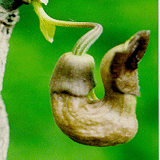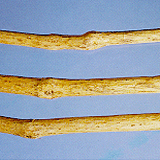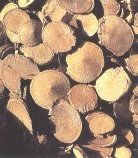Manchurian Aristolochia Stem
http://www.100md.com
《e Natural Health Center》
 |
 |
 |
 |
Herbs for Inducing Diuresis and Excreting Dampness
Manchurian Aristolochia Stem
Latin:
Caulis Aristolochiae Manshuriensis
Origin:
The stem of Aristolochia Manshuriensis Kom., a vine of the family Aristolochiaceae. It is a temperate-zone woody vine.
, http://www.100md.com
In China, the herb is mainly produced in such provinces as Jilin, Liaoning, Heilongjiang, etc.
Reaped in autumn, the stem is dried in the sun and sliced for use when raw.
Called Mutong in Chinese.
Properties:
Bitter in flavor, cold in nature, it is related to the heart, small intestine and urinary bladder channels.
, 百拇医药
Functions:
Induces diuresis and cures strangury (slow and painful spasmodic discharge of urine) as well as restores menstrual flow and stimulates milk secretion.
Applications:
1. To treat strangury due to heat, vexation with reddish urine and beriberi with edema:
a) Aphthae (roundish pearl-coloured specks or flakes in the mouth, on the lips, etc.) due to the flaring-up of heart-fire or vexation with reddish urine due to the downward movement of heart-fire:
, http://www.100md.com
This herb is mostly used in combination with raw rehmannia, licorice, bamboo leaves, etc., e.g., Daochi San.
b) Oliguria (secretion of a diminished amount of urine in relation to the fluid intake) with reddish urine and difficulty and pain in urination with dribbling urine due to damp-heat in the urinary bladder:
This herb is often used in combination with armstrong (Herba Polygoni Avicularis), fringed pink (Herba Dianthi), etc., e.g., Bazheng San.
, 百拇医药
c) Beriberi (endemic form of nerve inflammation due to an unbalanced diet) with edema and dysuria (difficult or painful discharge of urine):
This herb can be used together with umbellate pore fungus (Polyporus Umbellatus) perilla leaf and betel nuts, e.g., Mutong San.
2. To treat amenorrhea (absence or discontinuation or abnormal stoppage of the menstrual periods) with arthralgia due to damp-heat:
, 百拇医药
a) Amenorrhea due to damp-heat:
This herb can be used together with cowherb seed (Semen Vaccariae), pangolin scales, globethistle root (Radix Rhapontici seu Echinopsis), etc., or it can be taken with trotter soup.
b) Amenorrhea due to blood stasis, especially stasis and amenorrhea due to the blood-heat:
This herb is used in combination with safflower, peach kernels, salvia red root (Radix Salviae Miltiorrhizae), etc.
, 百拇医药
c) Arthralgia due to damp-heat:
This herb is mostly used in combination with large gentian root (Radix Gentianae Macrophyllae), fangji (Radix Stephaniae Tetrandrae), Job's tears (Semen Coicis), etc.
Dosage and Administration:
3-6 g.
Decoct this herb for oral administration.
Cautions on Use:
, 百拇医药
There have been reports that some cases of acute renal failure have been caused by decoctions of 60 g. Manchurian Aristolochia stem, so the dose of this herb should not be excessive.
Reference Materials:
'New Compilation of Materia Medica' :
"The Manchurian Aristolochia stem eliminates retained fluids and qi and induces diuresis and it is also an indispensable adjuvant or conductant herb. But it is not allowed to take too much of this herb because any excessive administration can dissipate primordial qi."
, 百拇医药
Toxic or Side Effects:
Modern Researches:
The Manchurian Aristolochia stem contains aristolochine, tannin, calcium, saponins, fatty oil, etc.
This herb has diuretic and cardiotonic effects.
This herb can inhibit Bacillus dysenteriae, typhoid bacillus and some dermatomyces. Aristolochine can inhibit the growth of tumor cells.
, 百拇医药
Other similar herbs
Mutong
The medicinal materials currently used in the name of mutong mainly include the four classes of guan mutong (Caulis Aristolochiae Manshuriensis) (i.e., this herb), chuan mutong (Caulis Clematidis Armandii) (armand clematis stem), huaitong (Caulis seu Radix Moupinensis) (moupin dutchmanspipe stem and root) and bai mutong (Caulis Akebiae Trifoliatae) (threeleaf akebia stem).
, 百拇医药
Among these four classes of mutong, guan mutong (Caulis Aristolochiae Manshuriensis) (Manchurian dutchmanspipe stem) is the woody stem of Aristolochia manshuriensis Kom. of Aristolochiaceae. Huaitong (Caulis seu Radix Moupinensis) is the woody stem of Aristolochia moupinensis Franch. of the same family. Bai mutong (Caulis Akebiae Trifoliatae) is only produced and sold in a small number of areas. The mutong recorded in the canons of materia medica through the ages refers to fiveleaf akebia stem (Caulis Akebiae) of Lardizabalaceae, and it is seldom used now.
, 百拇医药
Mutong and Tongcao:
Mutong and tongcao (rice-paper plant stem pith) (Medulla Tetrapanacis) are the Chinese names of different kinds of plants with different smells and tastes. But mutong today was called "tongcao" in ancient books, while tongcao now was known as tongtuomu in ancient books. Therefore they must be differentiated and cannot be confused., 百拇医药